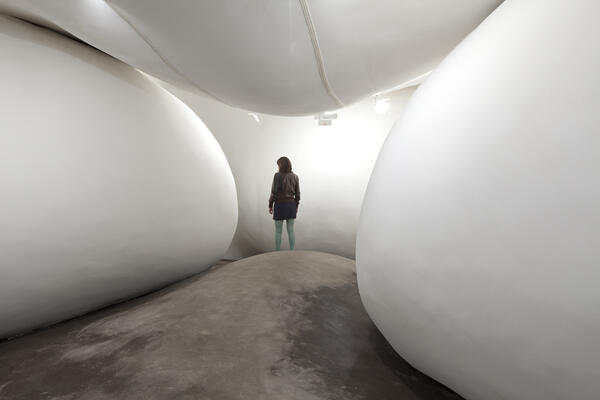Henrique Oliveira
Millan, Sao Paulo
Henrique Oliveira is known for his installations that transform the space around them. They are wooden formations that seem to breathe in and out, organic bulges that defy the linear nature of architecture and reinvent constructions. Walls, floors and ceilings succumb to a new logic, a material presence impossible to ignore.

While he has created a homage to Gustave Courbet’s L’Origine du Monde in his gigantic piece at the Bienal de São Paulo two years ago, a cavernous formation that resembled the vagina so clearly depicted by the French realist, Oliveira’s latest piece subverts the space of the Millan gallery, in São Paulo.
For the first time, he ceases to use discarded boards and scrapped wood to construct the kind of work that becomes a parasite to architecture. Here, Oliveira uses the same white walls of the gallery and the same cement floor to create the impression of a liquid reality, as if the building melted before the eyes of the visitor.
Walking in, a bulge grows from underneath the visitors’ feet, the walls cave in, sinuous and heavy, all while still maintaining the plastic look and feel of the gallery. There is nothing inside the space except for the space itself transformed, recreated, reshaped and twisted into a mass of forms that hold their apparent significance while at the same time seeming to obey a new rhythm.
Oliveira aims to do just that, to be, in this case, a parasite to the market. He offers no objects to be purchased, no visible piece to be observed except for the space redone. With that he seems to question the very nature of the business that goes on in such environments. His is a clever and very literal twist of the art gallery and its pristine white cube, here turned to nothing, obliterated in absolute fluidity.
-
 Realidade Líquida, 2012.
Realidade Líquida, 2012.
Architectural intervention at Galeria Millan/ Intervención arquitectónica en la Galería Millan
Photo/Foto: Everton Ballardin
Courtesy/Cortesía Galeria Millan, Sao Paulo



